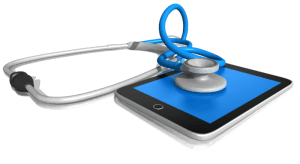Computerized medical records and medical errors
- Pen and paper medical records are plagued by illegible handwriting along with non-standardized and dangerous abbreviations, which can lead to medical errors. Electronic records are legible and are programmed to use only approved terminology and abbreviations.
- Electronic medical records may be supplemented with resources, such as information about medications, which is useful when prescribing drugs. Systems that include data from laboratory systems can incorporate clinical prompts, for example, which may warn against prescribing a specific medication in the presence of declining kidney or liver function. A prescriber can be warned when an order is entered for a medication to which the patient is allergic. These decision making supports may improve the quality of care and reduce medical errors.
- Use of bar coding technology reduces medication errors. The patient, medication, and nurse’s badge are all bar coded. Matches must occur before the medication is administered to the patient. Institutions observing nurses attempting to work around the system may make revisions to block these efforts to negate the safety features.
- Programs can be designed to include unit-specific and agency-wide standards of care and practice. The effect of these programs is to remind the provider of the essential elements that must be documented, through the use of clinical flags. For example, if the standard states that a fall prevention program must be initiated for high-risk patients, the program can remind the nurse of the standard. The nurse will not be allowed to delete required interventions and will be prompted to enter specific interventions and observations.
- Programs which incorporate the facility’s standards of care prompt the nurse to enter the essential information. For example, an admission assessment would include information that would identify the patient’s risk for skin breakdown or for a fall. This type of prompting focuses the nurse’s attention on key clinical issues and reminds the nurse to collect and enter data that would fulfill the standard of care.

There is a strong trend to computerization of medical records. This method of recording information about a patient offers many advantages.
Pat Iyer and Lee Houston, two legal nurse consultants, taught a practical program on how to analyze computerized medical records. Computerized Medical Records: Medical Legal Analysis is an all new one hour multimedia program geared to attorneys and legal nurse consultants. You’ll come away with concrete suggestions for making it easier to review records on the computer monitor. Buy the CD, MP3 audiofile or transcript. Get details about a practical program on how to analyze computerized medical records here.
From Patricia Iyer and Sharon Koob, Nursing Documentation, in Patricia Iyer, Barbara Levin, Kathleen Ashton and Victoria Powell, Nursing Malpractice, Fourth Edition.
